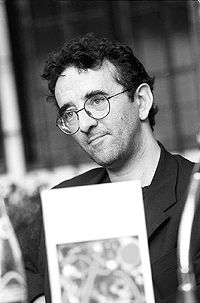The wave of media excitement generated in 2009 by the Chilean writer Roberto Bolaño was on a par with the announcement of a new Britney Spears release, even if up until that moment little was really known about him. Bolaño, who succumbed to liver failure in 2003 at the age of 50 while residing in Spain, became the toast of the international literary world thanks to his posthumously published novel 2666, purporting to tackle as its overarching theme the wholesale evil of the 20th century.
Ciudad Juarez

Bolaño painted his opus in broadly sweeping historical brushstrokes in which evil knows no bounds. Set in various countries over 80 years the novel is, however, sharply focused on the Mexican experience — although not the sort of experience government tourist authorities have any interest in highlighting, to wit: the appallingly still-unsolved serial murders of hundreds of young women during the 1990s in the northern border city of Juarez (called Santa Teresa in the book).
Bolaño lived in Mexico City during the 1970s and helped form a revolutionary literary group inspired by the Dadaists and the Beats (several members of
whom also found creative succor in Mexico at varying times during their flourishing). Bolaño and his poetic pranksters vigorously opposed what they considered to be insipid, government-sanctioned literature and poetry.
Another novel by Bolaño available in translation called The Savage Detectives is set in Mexico City during that era when he was a literary (and Trotskyite) radical. It follows the adventures of a set of anarchist poets called the Visceral Realists, based on Bolaño’s own movement, which was called Infrarrealismo. It’s hardly a storyline one pictures occurring in London, New York or Paris — but is somehow conceivable, even probable (as, indeed, it more or less was) for Mexico City. By the time he had written it, Bolaño had moved to Spain.
The dark aura of Mexico as evinced in 2666, however, clearly never left him.
Bolaño is by no means the first foreign writer to draw inspiration from Mexico — for better or worse (and no matter how long the length of stay) — and he won’t be the last. Rather, he joins a celebrated list of scribes that have collectively penned a body of work befitting the sometimes darkly fascinating country that is Mexico. These writers sought out Mexico by design, or Mexico found them, and they wrote of its mystery, charm or harshness while their protagonists waged war with their psyches, highlighting moral dilemmas that rage within us all.
Antonin Artaud
The French actor and poet Antonin Artaud came to Mexico “to make contact with the Red Earth” as he wrote in the poem “Indian Culture” (1946).
When he penned these lines, he had recently emerged half-starved from a nine-year period of incarceration in a lunatic asylum, having been subjected to more than 60 electro-shock treatments. He was dead two years later at the age of 54 from rectal cancer.
A decade earlier, Artaud had written the ground-breaking treatise The Theatre and its Double that dealt with the revolutionary concept of breaking down the barriers between performer and audience, where all parties would be drawn into a kind of spiritual immersion. He termed it “total theatre” and espoused the ideas in the chapter “Theatre of Cruelty.” It was to make a profound impact on post-World War II experimental theatre in Europe and the United States. Artaud developed the theory while he was in Mexico.
Artaud first came to Mexico City in 1936, then left to journey on horseback to the Tarahumara region of northern Mexico. He spent several months with the Tarahumara people, partaking in peyote and other rituals. Inspired by a community that embraced the spirit world as concretely as the physical, Artaud returned to France determined that his first “total theatre” production should be no less than a dramatization of the Conquest of Mexico. But his mental condition deteriorated, and the project was never realized.
Hart Crane
The American poet Hart Crane, most famous for The Bridge (1930), also spent a good deal of time living in and writing about Mexico. Like Artaud, Crane also planned to write an epic on the Mexican Conquest. Similarly, it was never accomplished.
When Crane left Mexico to return to New York in 1932, he jumped off the ship he was traveling on when it was a couple hundred miles north of Havana out at sea, to take up residence in Davy Jones’ Locker. He was 32. His body was never found.
B. Traven
B. Traven is a writer whose name may not spring to everyone’s lips, although perhaps the classic John Huston-Humphrey Bogart movie Treasure of the Sierra Madre (1948) — adapted from Traven’s novel of the same name — does.
The body of Traven’s work is almost wholly derived from his love of Mexico and his hatred of the injustices he so often found here. A mysterious character who guarded his identity to such a profound degree that a considerable legend evolved as a result (perhaps making him even more famous than had he not done so), it is speculated that Traven (the name being almost certainly a pseudonym) was born in Chicago in 1890 and spent his youth in Germany. He was both an actor and a revolutionary journalist who later became a seaman working on tramp steamers. He ended up in Mexico in the early 1920s, and stayed.
Traven’s feelings ran deepest for the indigenous people of Mexico, and while in Chiapas he observed the conditions of debt slavery and peonage under which the Indians suffered. Traven created an epic revolving around the birth of the Mexican Revolution known as the “jungle novels.” The six novels comprised Government; The Carretta; March to the Monterria; Trozas; The Rebellion of the Hanged and The General from the Jungle.
The novels are infused with an intimate insight into the lives of the dispossessed that ignites in long overdue, righteous revolution. For his supposed wanderings, Traven’s writings (with the exception of his first novel The Death Ship) almost exclusively sourced Mexico. He (evidently) died in the capital in 1969.
Graham Greene
The Power and the Glory (1940) by the prolific British writer Graham Greene (1904-1991) is considered by many to be his masterpiece.
It tells the story of the “whisky priest” on the run in a nameless southern Mexican state (Tabasco) during the anti-clerical purges of the 1930s. Green was driven by his own wrestling with Roman Catholicism to produce an impassioned work tackling the duality of moral nature in a novel that brought him his most popular as well as critical acclaim.
Greene spent only two months in Mexico — during March and April of 1938 — on a visit to see the effect of the government-organized purges against the Catholic clergy. From this he first wrote the travel book The Lawless Roads (1938) — also very religious in tone, and a clear precursor to The Power and the Glory.
Two books, then, from two months in Mexico.
Malcolm Lowry
Malcolm Lowry (1909-1957) was another British writer whose greatest literary achievement was realized from connecting with the Mexican experience, like Bolaño, at its darkest.
His novel Under the Volcano (1947) is considered to be a classic of 20th century literature. He wrote it while living in Cuernavaca, Morelos. First conceived in 1936 as a short story about a British diplomat who drinks himself to death, the work metamorphosed into a gargantuan opus defining the human condition as an alcoholic hallucination, interweaving the legendary fatalism of Mexico with the decline of the protagonist, Geoffrey Firmin.
Lowry left Mexico, and never wrote anything that came close to matching the power of Under the Volcano. The bulk of his other work was published posthumously after his booze-addled death in England at the age of 48.
D. H. Lawrence
D. H. Lawrence (1885-1930) wrote the heavily philosophical Mexico novel The Plumed Serpent while staying in Oaxaca in 1926, as well as a collection of short stories called Mornings in Mexico. Unfortunately, Mexico did not seem to agree with the health of the great journeyman writer — he caught malaria, dysentery and tuberculosis during his relatively short stay, the last disease ultimately causing his death.
John Steinbeck
Nobel Prize winner John Steinbeck (1902-1968) wrote Log from the Sea of Cortez (1941) that catalogued a scientific expedition around the Baja region with biologist friend Edward Rickets in 1940.
Something of the Mexican spirit must have remained with Steinbeck, who went on to pen the screenplay for Zapata, Elia Kazan’s 1952 film starring Marlon Brando as the Mexican revolutionary leader. LINK
Aldous Huxley
British author Aldous Huxley (1894-1963) traveled through Mexico as well, and wrote Beyond the Mexique Bay (1934). This fascinating travel book includes chapters on Oaxaca, Puebla, Cholula, Taxco, Mitla and Mexico City.
Burroughs and the Beats
U.S. writer William S. Burroughs (1914-1997) was notorious throughout the 1950s and ’60s for his heroin drug addiction, various tangles with the law, outspoken homosexuality, “pornographic” novels such as Naked Lunch (1959) and, perhaps most of all, for shooting dead his common-law wife Joan Vollmer in Mexico City in 1951 during an apparent game of “William Tell.”
Burroughs moved to the Colonia Roma district of the capital in 1949 rather than stand trial in New Orleans over drug-related offenses. He liked Mexico so much he planned to settle here permanently until the shooting tragedy necessitated his departure. It was in Mexico City that Burroughs wrote his famous novel, the cult classic Junkie (1953).
Other Beat Generation writers to be inspired by Mexico include Jack Kerouac (he wrote Mexico City Blues and Tristessa during the late 1950s following a visit to Burroughs) and the poet Allen Ginsberg.
And others

The writers and their novels have kept coming, and some make for stunningly dramatic — The Power of the Dog (Don Winslow; 2005) — and sometimes hilarious — The Dog of the South (Charles Portis; 1979) — reading.
The recent publication of Last Stop Salina Cruz by Scottish writer David Lale has its protagonist following in the footsteps of the fabulously mysterious poet boxer Arthur Cravan, also a crackerjack Dadaist, who vanished after leaving Mexico in 1918 to parts unknown — some say to a watery grave in the Gulf of Tehuantepec, but nothing is certain.
Last Stop Salina Cruz is an excellent debut novel with an assured and at times brilliant grasp of language, although its inexhaustible misanthropy and negativism can sometimes drag the reader into the abyss. It is true that the strange encounters the protagonist experiences on the road (memorably an Australian surfer on the beach at Oaxaca) become oddly and unexpectedly moving. Yet when the hand of friendship is proffered — no matter how drunken or drug-addled in may be — the narrator is compelled to reject the overture, balking in discomfort (here somewhat mirroring Cravan’s outraged determination to bend the world to his own will, and dare those who would worship him to lose faith in him and, finally, hate his guts).
Not surprisingly, Lale has little interest in describing Mexico in postcard-radiant terms — yet the work is all the more convincing for it. He joins Bolaño (if admittedly somewhat on a lesser scale) in adding a new volume to the canon of literature that draws from Mexico’s deep waters.

